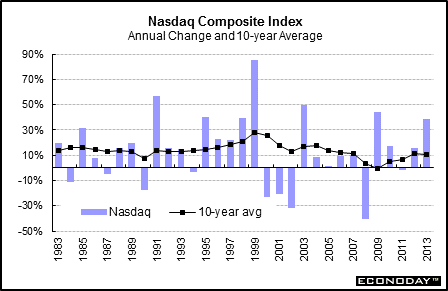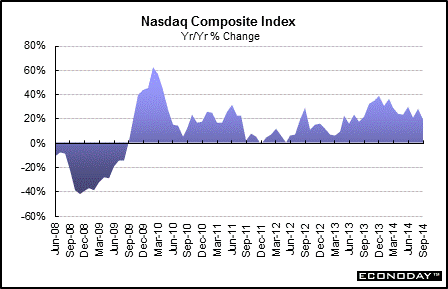
|
Long Term Perspective
The Nasdaq Composite is a stock market index of the common stocks and similar securities listed on the NASDAQ stock market. It has over 3,000 components. This chart underscores the high volatility of this market – notice the wide range of year-over-year growth and decline. The Nasdaq composite is known for its focus on high tech companies but it also includes industrials, banks, insurance, transportation and biotechnology stocks. Historically, newer companies that were not able to meet requirements for listing on the New York Stock Exchange (NYSE) or the American Stock Exchange (AMEX) were traded on Nasdaq. In recent years, some big names (e.g. Sun Microsystems) that could have listed on the NYSE have remained on Nasdaq.
The Nasdaq composite index surged 38.3 percent in 2013, following a gain of 15.9 percent the year before. The 10-year average for the Nasdaq for the latest year slipped to 10.2 percent from 11.4 percent in 2012. This index tends to include new and growing companies and it traditionally has annual gains that are larger than for the S&P 500 or the Dow Jones Industrials during expansion. But they also are susceptible to greater weakness during downturns.
Short Term Perspective
During 2008 and early 2009 the recession undermined this sector. But in latter 2009, 2010, 2011, and early 2012 better economic data boosted the Nasdaq net. But along the way, in mid-2011, weak economic news and European sovereign debt problems knocked equities down with Congressional squabbling over debt ceiling legislation also coming into play. At year end, the Nasdaq weakened despite improved economic news and progress in dealing with European sovereign debt. At the start of 2012, the Nasdaq showed strength on healthy corporate earnings and better economic news. But at mid-year, worries about default on European sovereign debt and slower economic growth led to softer stocks. Better news on the indicator front and improvement in financial issues in Europe boosted stocks in very early 2013. Concern about potential early tapering of asset purchases by the Fed weighed on stock at-mid-year. But continued moderate economic growth and an easing of worries about the impact of Fed tapering lifted stocks in latter 2013. A soft economy and concerns about Ukraine weighed on equities in 2014 along with slowing growth in Europe and Asia.
The Nasdaq in September was up 19.1 percent on a year-ago basis versus 27.6 percent the prior month.
The Nasdaq slipped 1.9 percent in September, following a jump of 4.8 percent in August.
|
|||||||
| Legal Notices | ©Copyright 1998-2025 Econoday, Inc. |
powered by
![[Econoday]](images/logo.gif)
![[Apple App Store]](/images/AppleAppStore.png) ![[Econoday on Kindle]](/images/kindle.jpg) 
|
||||||


